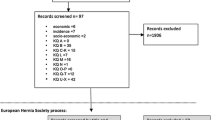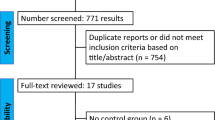Abstract
Infants with congenital abdominal wall defects pose an interesting and challenging management issue for surgeons. We attempt to review the literature to define the current treatment modalities and their application in practice. In gastroschisis, the overall strategies for repair include immediate closure or delayed operative repair. The best level of data for gastroschisis is grade C and appears to support that there is no major difference in survival between immediate closure or delayed repair. In patients with omphalocele, the management techniques are more varied consisting of immediate closure, staged closure or delayed closure after epithelialization. The literature is less clear on when to use one technique over the other, consisting of mostly grade D and E data. In patients with omphalocele, a registry to collect information on patients with larger defects may help determine which of the management strategies is optimal.
Similar content being viewed by others
References
Holcomb GW, Murphy JP (2010) Ashcraft’s pediatric surgery, 5th edn. Saunders Elsevier, Amsterdam, pp 625–636
Grosfeld JL, O’Neill JA, Fonkalsrud EW, Coran AG (2006) Pediatric surgery, 6th edn. Mosby Elsevier, vol 2, pp 1157–1171
Feldkamp ML, Carey JC, Sadler TW (2007) Development of gastroschisis: review of hypotheses, a novel hypothesis, and implications for research. Am J Med Genet A 143(7):639–652
Hoyme HE, Higginbottom MC, Jones KL (1981) The vascular pathogenesis of gastroschisis: intrauterine interruption of the omphalomesenteric artery. J Pediatr 98(2):228–231
Louw JH, Barnard CN (1955) Congenital intestinal atresia; observations on its origin. Lancet 269(6899):1065–1067
Barnard CN, Louw JH (1956) The genesis of intestinal atresia. Minn Med 39(11):745–749
Werler MM, Sheehan JE, Mitchell AA (2003) Association of vasoconstrictive exposures with risks of gastroschisis and small intestinal atresia. Epidemiology 14(3):349–354
deVries PA (1980) The pathogenesis of gastroschisis and omphalocele. J Pediatr Surg 15(3):245–251
Klein MD (2004) Robot-enhanced fetoscopic surgery. J Pediatr Surg 39(10):1463–1465
Shanske AL, Pande S, Aref K et al (2003) Omphalocele–exstrophy–imperforate anus–spinal defects (OEIS) in triplet pregnancy after IVF and CVS. Birth Defects Res A Clin Mol Teratol 67(6):467–471
Izant RJ Jr, Brown F, Rothmann BF (1966) Current embryology and treatment of gastroschisis and omphalocele. Arch Surg 93(1):49–53
Yoshioka H, Aoyama K, Iwamura Y, Muguruma T (2004) Two cases of left-sided gastroschisis: review of the literature. Pediatr Surg Int 20(6):472–473
Maurel A, Harper L, Knezynski S, Michel JL, De Napoli-Cocci S (2010) Left-sided gastroschisis: is it the same pathology as on the right-side? Eur J Pediatr Surg 20(1):60–62
Suver D, Lee SL, Shekherdimian S et al (2008) Left-sided gastroschisis: higher incidence of extraintestinal congenital anomalies. Am J Surg 195(5):663–666
Baerg J, Kaban G, Tonita J et al (2003) Gastroschisis: a sixteen year review. J Pediatr Surg 38(5):771–774
Baird PA, MacDonald EC (1981) An epidemiologic study of congenital malformations of the anterior abdominal wall in more than half a million consecutive live births. Am J Hum Genet 33(3):470–478
Forrester MB, Merz RD (1999) Epidemiology of abdominal wall defects, Hawaii, 1986–1997. Teratology 3(4):117–123
Laughon M, Meyer R, Bose C et al (2003) Rising birth prevalence of gastroschisis. J Perinatol 23(4):291–293
Reid Kp, Dickinson JE, Doherty DA (2003) The epidemiologic incidence of congenital gastroschisis in Western Australia. AmJ Obstet Gynecol 16(1):764–768
Werler MM, Sheehan JE, Mitchell AA (2002) Maternal medication use and risks of gastroschisis and small intestinal atresia. Am J Epidemiol 155(1):26–31
Calozari E, Volpato S, Bianchi F et al (1993) Omphalocele and gastroschisis: a collaborative study of five Italian congenital malformation registries. Teratology 47(1):47–55
Barisic O, Clementi M, Hausler M et al (2001) Evaluation of prenatal ultrasound diagnosis of fetal abdominal wall defects by 19 European registries. Ultrasound Obstet Gynecol 18(4):301–304
Gibbin C, Touch S, Broth RE, Berghella V (2003) Abdominal wall defects and congenital heart disease. Ultrasound Obstet Gynecol 21(4):334–337
Saller Dn Jr, Conick JA, Palomaki GE et al (1994) Second-trimester maternal serum alpha-fetoprotein, unconjugated estriol, and hCG levels in pregnancies with ventral wall defects. Obstet Gynecol 84(5):852–855
Tucker JM, Brumfield CG, Davis RO et al (1992) Prenatal differentiation of ventral abdominal wall defects. Are amniotic fluid markers useful adjuncts? J Reprod Med 37(5):445–448
Beckwith JB, Wang LI, Donnell GN et al (1964) Hyperplastic fetal visceromegaly with macroglossia, omphalocele, cytomegaly of adrenal fetal cortex, postnatal somatic gigantism and other abnormalities: Newly recognized syndrome. Proc Am Pediatr Soc 1064:16–17
Franceschini P, Guala A, Licata D et al (2003) Gershoni–Baruch syndrome: report of a new family confirming autosomal recessive inheritance. Am J Med Genet 122A(2):174–179
Chassaing N, Lacombe D, Carles D et al (2003) Donnai–Barrow syndrome: four additional patients. Am J Med Genet 121A(3):258–262
Bamforth JS, Leonard CO, Chodirker VN et al (1989) Congenital diaphragmatic hernia, coarse facies, and acral hypoplasia: Fryns syndrome. Am J Med Genet 32(1):93–99
Yatsenko SA, Mendoza-Londono R, Belmont JW et al (2003) Omphalocele in trisomy 3q: further delineation of phenotype. Clin Genet 64(5):404–413
Brantberg A, Blaas HG, Haugen SE et al (2005) Characteristics and outcome of 90 cases of fetal omphalocele. Ultrasound Obstet Gynecol 26(5):527–537
Torfs CP, Curry CJ (1993) Familial cases of gastroschisis in a population based registry. Am J Med Genet 45(4):465–467
Snyder CL, Peter SD (2005) Trends in mode of delivery for gastroschisis infants. Am J Perinatol 22(7):391–396
Moore TC, Collins DL, Catanzarite V, Hatch EI Jr (1999) Preterm and particularly pre-labor cesarean section to avoid complications of gastroschisis. Pediatr Surg Int 15(2):97–104
Boutros J, Regier M, Skarsgard ED (2009) Is timing everything? The influence of gestational age, birth weight, route, and intent of delivery on outcome in gastroschisis. J Pediatr Surg 44(5):912–917
Moir CR, Ramsey PS, Ogburn PL, Johnson RV, Ramin KD (2004) A prospective trial of elective preterm delievery for fetal gastroschisis. Am J Perinatol 21(5):289–294
Zanardo V, Simbi AK, Franzoi M, Solda G, Salvadori A, Trevisanuto D (2004) Neonatology respiratory morbidity risk and mode of delivery at term: influence of timing of elective caesarean delivery. Acta Paediatr 93(5):643–647
Maramreddy H, Fisher J, Slim M, Lagamma EF, Parvez B (2009) Delivery of gastroschisis patients before 37 weeks of gestation is associated with increased morbidities. J Pediatr Surg 44(7):1360–1366
Bethel CA, Seashore JH, Touloukian RJ (1989) Cesarean section does not improve outcome in gastroschisis. J Pediatr Surg 24(1):1–3
Olesevich M, Alexander F, Khan M, Cotman K (2005) Gastroschisis revisited: role of intraoperative measurement of abdominal pressure. J Pediatr Surg 40(5):789–792
Lacey SR, Carris LA, Beyer AJ III, Azizkhan RG (1993) Bladder pressure monitoring significantly enhances care of infants with abdominal wall defects: a prospective clinical study. J Pediatr Surg 28(10):1374–1375
Masey SA, Koehler RC, Buck JR et al (1985) Effect of abdominal distension on central and regional hemodynamics in neonatal lambs. Pediatr Res 19(12):1244–1249
Lacey SR, Bruce J, Brooks SP et al (1987) The relative merits of various methods of indirect measurement of intra-abdominal pressure as a guide to closure of abdominal wall defects. J Pediatr Surg 22(12):1207–1211
Pastor AC, Phillips JD, Fenton SJ et al (2008) Routine use of a SILASTIC spring-loaded silo for infants with gastroschisis: a multicenter randomized controlled trial. J Pediatr Surg 43(10):1807–1812
Singh SJ, Fraser A, Leditschke JF et al (2003) Gastroschisis: determinants of neonatal outcome. Pediatr Surg Int 19(4):260–265
Kidd JN Jr., Jackson RJ, Smith SD, Wagner CW (2003) Evolution of staged versus primary closure of gastroschisis. Ann Surg 237(6):759–764 (discussion 764–765)
Pastor AC, Phillips JD, Fenton SJ et al (2008) Routine use of a SILASTIC spring-loaded silo for infants with gastroschisis: a multicenter randomized controlled trial. J Pediatr Surg 43(10):1807–1812
Weinsheimer RL, Yanchar NL, Bouchard SB et al (2008) Gastroschisis closure–does method really matter? J Pediatr Surg 43(5):874–878
Riboh J, Abrajano CT, Garber K et al (2009) Outcomes of sutureless gastroschisis closure. J Pediatr Surg 44(10):1947–1951
Jensen AR, Waldhausen JH, Kim SS (2009) The use of a spring-loaded silo for gastroschisis: impact on practice patterns and outcomes. Arch Surg 144(6):516–519
Davies MW, Kimble RM, Woodgate PG (2002) Ward reduction without general anaesthesia versus reduction and repair under general anaesthesia for gastroschisis in newborn infants. Cochrane Database Syst Rev (3):CD003671
Rao SC, Pirie S, Minutillo C et al (2009) Ward reduction of gastroschisis in a single stage without general anaesthesia may increase the risk of short-term morbidities: results of a retrospective audit. J Paediatr Child Health (epub ahead of print)
Allotey J, Davenport M, Njere I et al (2007) Benefit of preformed silos in the management of gastroschisis. Pediatr Surg Int 23(11):1065–1069
Bonnard A, Zamakhshary M, de Silva N, Gerstle JT (2008) Non-operative management of gastroschisis: a case-matched study. Pediatr Surg Int 24(7):767–771
Mann S, Blinman TA, Douglas Wilson R (2008) Prenatal and postnatal management of omphalocele. Prenat Diagn 28(7):626–632
Rijhwani A, Davenport M, Dawrant M et al (2005) Definitive surgical management of antenatally diagnosed exomphalos. J Pediatr Surg 40(3):516–522
Alaish SM, Strauch ED (2006) The use of Alloderm in the closure of a giant omphalocele. J Pediatr Surg 41(3):37–39
Kilbride KE, Cooney DR, Custer MD (2006) Vacuum-assisted closure: a new method for treating patients with giant omphalocele. J Pediatr Surg 41(1):212–215
Martin AE, Khan A, Kim DS et al (2009) The use of intraabdominal tissue expanders as a primary strategy for closure of giant omphaloceles. J Pediatr Surg 44(1):178–182
Pacilli M, Spitz L, Kiely EM et al (2005) Staged repair of giant omphalocele in the neonatal period. J Pediatr Surg 40(5):785–788
Bawazir OA, Wong A, Sigalet DL (2003) Absorbable mesh and skin flaps or grafts in the management of ruptured giant omphalocele. J Pediatr Surg 38(5):725–728
Kapfer SA, Keshen TH (2006) The use of human acellular dermis in the operative management of giant omphalocele. J Pediatr Surg 41(1):216–220
Lee SL, Beyer TD, Kim SS et al (2006) Initial nonoperative management and delayed closure for treatment of giant omphaloceles. J Pediatr Surg 41(11):1846–1849
Festen C, Severijnen R, Staak F (1987) Nonsurgical (conservative) treatment of giant omphalocele. Clin Pediatr 26(1):35–39
Cosman BC, Schullinger JN, Bell JJ et al (1988) Hypothyroidism caused by topical povidone-iodine in a newborn with omphalocele. J Pediatr Surg 23(4):356–358
Jackson HJ, Sutherland RM (1981) Effect of povidone-iodine on neonatal thyroid function. Lancet 2(8253):992–993
Whitehouse JS, Gourlay DM, Masonbrink AR, Aiken JJ, Calkins CM, Sato TT, Arca MJ (2010) Conservative management of giant omphalocele with topical povidone-iodine and its effect on thyroid function. J Pediatr Surg 45(6):1192–1197
van Eijck FC, de Blaauw I, Bleichrodt RP et al (2008) Closure of giant omphaloceles by the abdominal wall component separation technique in infants. J Pediatr Surg 43(1):246–250
Pereira RM, Tatsuo ES, Simoes e Silva AC et al (2004) New method of surgical delayed closure of giant omphaloceles: Lazaro da Silva’s technique. J Pediatr Surg 39(7):1111–1115
Patel G, Sadiq J, Shenker N, Impey L, Lakhoo K (2009) Neonatal survival of prenatally diagnosed exomphalos. Pediatr Surg Int 25(5):413–416
Koivusalo A, Lindahl H, Rintala RJ (2002) Morbidity and quality of life in adult patients with a congenital abdominal wall defect: a questionnaire survey. J Pediatr Surg 37(11):1594–1601
Tunell WP, Puffinbarger NK, Tuggle DW et al (1995) Abdominal wall defects in infants. Survival and implications for adult life. Ann Surg 221(5):525–528
van Eijck FC, Hoogeveen YL, van Weel C, Rieu PN, Wijnen RM (2009) Minor and giant omphaloceles: long-term outcomes and quality of life. J Pediatr Surg 44(7):1355–1359
Foglia R, Kane A, Becker D, Asz-Sigall J, Mychaliska G (2006) Management of giant omphalocele with rapid creation of abdominal domain. J Pediatr Surg 41(4):704–709
De Ugarte DA, Asch MJ, Hedrick MH, Atkinson JB (2004) The use of tissue expanders in the closure of a giant omphalocele. J Pediatr Surg 39(4):613–615
Bax NM, van der Zee DC, Pull ter Gunne AJ, Rövekamp MH (1993) Treatment of giant omphalocele by enlargement of the abdominal cavity with a tissue expander. J Pediatr Surg 28(9):1181–1184
Conflict of interest
None.
Author information
Authors and Affiliations
Corresponding author
Rights and permissions
About this article
Cite this article
Mortellaro, V.E., Peter, S.D.S., Fike, F.B. et al. Review of the evidence on the closure of abdominal wall defects. Pediatr Surg Int 27, 391–397 (2011). https://doi.org/10.1007/s00383-010-2803-2
Accepted:
Published:
Issue Date:
DOI: https://doi.org/10.1007/s00383-010-2803-2




